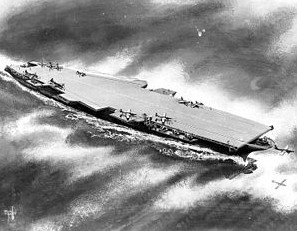
USS United States (CVA-58)
Wikipedia | 2013-11-29 11:55
USS United States (CVA-58), the third ship of the United States Navy named for the nation, was to be the lead ship of a new design of aircraft carrier. On 29 July 1948, President Harry Truman approved construction of five "supercarriers", for which funds had been provided in the Naval Appropriations Act of 1949. The keel of the first of the five planned postwar carriers was laid down on 18 April 1949 at Newport News Drydock and Shipbuilding.[2] However, the program was subsequently canceled, the United States was not completed, and the other four planned carriers were never built.
Design
Early design discussions included debate on the aircraft carrier's mission. One view was that it could be built only for nuclear attack, against Soviet naval bases, using heavy bombers with a small hangar deck for a limited fighter escort and a small magazine for a small number of heavy nuclear weapons. Another plan was that it could be built with conventional attack capability with a large hangar deck for a large air wing and a large magazine.[5] The nuclear attack supporters won in the initial design stage, but the design was modified to carry more fighters. The flush-deck United States was designed to launch and recover the 100,000 pound (45 t) aircraft required to carry early-model nuclear weapons, which weighed as much as five tons. The ship would have no island (command tower structure). It would be equipped with four aircraft elevators located at the deck edges, and four catapults, two at the bow with the outer ones at the deck edges staggered back. The carrier was designed for dual operations: landing at the rear of the ship and launching aircraft from the bow catapults, as well as launching from the four catapults simultaneously. The construction cost of the new ship alone was estimated at US$189 million.
Proposed operations
United States was also designed to provide air support for amphibious forces and to conduct sea control operations, but its primary mission was long-range nuclear bombardment. That mission was virtually certain to make the ship a target of inter-service rivalries over missions and funding. The United States Air Force viewed United States as a challenge to their monopoly on strategic nuclear weapons delivery.
Keel laid and cancellation
Swayed by limited funds and bitter opposition from the United States Army and Air Force, Secretary of Defense Louis A. Johnson announced on 23 April 1949—five days after the ship's keel was laid down—the cancellation of construction of the United States. Secretary of the Navy John Sullivan immediately resigned, and the subsequent "Revolt of the Admirals" cost Admiral Louis Denfeld his position as Chief of Naval Operations—though atomic bombs soon went to sea on the aircraft carrier USS Franklin D. Roosevelt in 1950.
Share this page




















